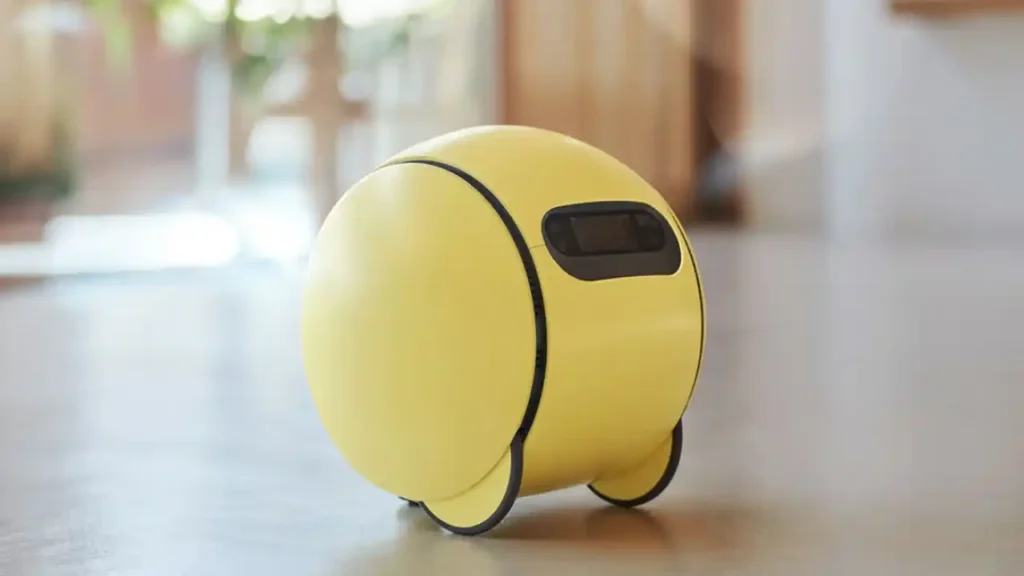The Samsung Ballie is a rolling home robot driven by AI that can be used as a pet monitor, smart assistant, mobile companion, and projector. It uses Google Gemini AI and Samsung’s own models to talk, move, and record naturally, handle smart devices, and improve daily tasks with voice, video, and motion.

The Samsung Ballie robot could be your dream pet if you’ve ever wished your smart home devices could move around and follow you around like a loyal dog. This moving yellow orb driven by AI isn’t meant to scare or impress with its humanoid looks. Instead, it’s meant to help, entertain, and fit into your daily life.
We’ll talk about what Ballie is, how it works, where it fits in the world of home robots, and whether it’s really more than just a tech toy in this blog.
What is Samsung Ballie and Why It Matters
The Samsung Ballie is a ball-shaped AI robot friend that was made to be used at home. This thing is about the size of a bowling ball, and its only job is to help you move things around, play music, and run your smart home. It’s kind of like a mobile version of Google Home or Alexa. It can move, project, and even be your security camera.
Ballie is proud to be a smart, rolling ball with a great personality. It’s not trying to look like a person, a pet, or a bug.
How Samsung Ballie Works
Sensors, cameras, and AI smarts built into Ballie make it work. It can understand your words, find visuals around the house, and change based on your preferences thanks to multimodal AI from Google Gemini and Samsung’s own language models.
Here’s what makes Samsung Ballie move and think:
- Mobility: Small front wheels and a rear stabilizer help it roll smoothly across rooms
- Sensing: Ballie uses vision and audio input to understand where you are and what you need
- Learning: Over time, it picks up on your routines — when you wake up, where you go, what devices you use
- Projector Brain: Ballie’s built-in projector can display content on walls, floors, or ceilings — from videos to schedules
And all of this is controlled using natural voice commands, so you don’t have to tap or swipe.
What Can Ballie Actually Do in Real Life
Here’s where it gets fun. Samsung Ballie isn’t just a mobile speaker or camera. It brings a surprising number of useful features to daily home life:
- Clean floors (though it’s not a full replacement for vacuum robots)
- Monitor pets or intruders as a mobile security camera
- Remind you of tasks, appointments, and traffic updates
- Control smart home devices like lights, thermostats, and appliances
- Project workouts onto your wall and act as your AI fitness buddy
- Display movies or videos on ceilings or walls for ambient entertainment
- Create interactive buttons on the floor you can press with your feet
- Give personalized suggestions for health or style based on your day
Pros and Cons of Using Ballie at Home
Like any smart device, Samsung Ballie isn’t perfect. Let’s break down its benefits and drawbacks.
Pros
- Friendly design makes it approachable for kids and elders
- Multiple use cases — security, cleaning, reminders, entertainment
- Portable and voice-controlled with built-in projector
- Learns your routines and adapts to your preferences over time
- Good for small spaces, dorms, or smart apartments
Cons
- Not available for purchase yet (expected summer 2025 in US and South Korea)
- Unknown price — likely premium
- Limited to flat surfaces (can’t climb stairs or manipulate objects)
- Projector performance depends on room lighting
- Privacy concerns — mobile camera rolling around the house
- Could get stuck or bumped (pets might treat it like a toy)
How Ballie Compares to Other Home Robots
| Feature | Samsung Ballie | LG Q9 AI Agent |
|---|---|---|
| Form & Mobility | Rolling spherical design (~bowling‑ball size) with two front wheels and rear stabilizer | Walking robot with two-wheeled legs that bounce and sway to express emotion and navigate bumps |
| Interaction Style | No animated face; simple, cute, pet-like personality | Digital eyes on a screen to express emotion and build empathy |
| AI & Communication | Uses Google Gemini and Samsung’s AI models for multimodal conversational interaction | Voice and image recognition powered by Qualcomm’s AI platform |
| Core Functionalities | Smart home control, reminders, health suggestions, projection, pet monitoring | Controls appliances, monitors sleep and energy, provides emotional support |
| Built‑in Display | Full projector that displays on walls, floors, and ceilings; adapts to distance | Facial display with expressive eyes; no projector |
| Emotional Engagement | Cute rolling movement and interactive projections to engage users | Expressive digital face, body sway, greeting gestures, and emotional cues |
| Release Status | Launching summer 2025 in the US and South Korea; price not announced yet | Concept demo revealed at CES 2024; no official release date announced |
Is Ballie Just Hype or a Real Shift in Smart Homes?
While some critics say Ballie might just be a “mobile smart display with wheels,” its blend of mobility, projection, AI learning, and interaction goes beyond what existing home assistants offer. It’s not replacing your vacuum, tablet, or dog — but it’s trying to bring a touch of companionship and physical presence to your smart ecosystem.
What Ballie really represents is a shift in how we interact with AI — not through flat screens or static hubs, but through responsive, roaming devices that feel alive.
Final Thoughts
Samsung Ballie isn’t just another cute robot — it’s a thoughtful experiment in what AI can be when it moves with you, speaks to you, and adapts to your life in small, meaningful ways. With AI smarts, a built-in projector, and friendly design, Ballie could redefine how we view home assistants — not just as tools, but as companions.
Would you explore Samsung Ballie in your home workflow? Let us know.







